转自:http://blog.csdn.net/hesays/article/details/41850873
Matlab 形态学图像处理
本章的练习主要是形态学的一些基本概念和技术,这些构成了一组提取图像特征的有力工具,针对二值图像和灰度图像的腐蚀、膨胀和重构的基本操作可以组合使用,以执行非常宽泛的任务。其练习代码和结果如下
- %% 第9章 形态学处理
- %% imdilate膨胀
- clc
- clear
- A1=imread('.\images\dipum_images_ch09\Fig0906(a)(broken-text).tif');
- info=imfinfo('.\images\dipum_images_ch09\Fig0906(a)(broken-text).tif')
- B=[0 1 0
- 1 1 1
- 0 1 0];
- A2=imdilate(A1,B);%图像A1被结构元素B膨胀
- A3=imdilate(A2,B);
- A4=imdilate(A3,B);
- subplot(221),imshow(A1);
- title('imdilate膨胀原始图像');
- subplot(222),imshow(A2);
- title('使用B后1次膨胀后的图像');
- subplot(223),imshow(A3);
- title('使用B后2次膨胀后的图像');
- subplot(224),imshow(A4);
- title('使用B后3次膨胀后的图像');
图像膨胀处理过程运行结果如下:

- %% imerode腐蚀
- clc
- clear
- A1=imread('.\images\dipum_images_ch09\Fig0908(a)(wirebond-mask).tif');
- subplot(221),imshow(A1);
- title('腐蚀原始图像');
- %strel函数的功能是运用各种形状和大小构造结构元素
- se1=strel('disk',5);%这里是创建一个半径为5的平坦型圆盘结构元素
- A2=imerode(A1,se1);
- subplot(222),imshow(A2);
- title('使用结构原始disk(5)腐蚀后的图像');
- se2=strel('disk',10);
- A3=imerode(A1,se2);
- subplot(223),imshow(A3);
- title('使用结构原始disk(10)腐蚀后的图像');
- se3=strel('disk',20);
- A4=imerode(A1,se3);
- subplot(224),imshow(A4);
- title('使用结构原始disk(20)腐蚀后的图像');
图像腐蚀处理过程运行结果如下:

- %% 开运算和闭运算
- clc
- clear
- f=imread('.\images\dipum_images_ch09\Fig0910(a)(shapes).tif');
- %se=strel('square',5');%方型结构元素
- se=strel('disk',5');%圆盘型结构元素
- imshow(f);%原图像
- title('开闭运算原始图像')
运行结果如下:

- %开运算数学上是先腐蚀后膨胀的结果
- %开运算的物理结果为完全删除了不能包含结构元素的对象区域,平滑
- %了对象的轮廓,断开了狭窄的连接,去掉了细小的突出部分
- fo=imopen(f,se);%直接开运算
- figure,subplot(221),imshow(fo);
- title('直接开运算');
- %闭运算在数学上是先膨胀再腐蚀的结果
- %闭运算的物理结果也是会平滑对象的轮廓,但是与开运算不同的是,闭运算
- %一般会将狭窄的缺口连接起来形成细长的弯口,并填充比结构元素小的洞
- fc=imclose(f,se);%直接闭运算
- subplot(222),imshow(fc);
- title('直接闭运算');
- foc=imclose(fo,se);%先开后闭运算
- subplot(223),imshow(foc);
- title('先开后闭运算');
- fco=imopen(fc,se);%先闭后开运算
- subplot(224),imshow(fco);
- title('先闭后开运算');
开闭运算结果如下:

- %先膨胀再腐蚀
- fse=imdilate(f,se);%膨胀
- %gcf为得到当前图像的句柄,当前图像是指例如PLOT,TITLE,SURF等
- %get函数为得到物体的属性,get(0,'screensize')为返回所有物体screensize属性值
- %set函数为设置物体的属性
- figure,set(gcf,'outerposition',get(0,'screensize'));%具体目的是设置当前窗口的大小
- subplot(211),imshow(fse);
- title('使用disk(5)先膨胀后的图像');
- fes=imerode(fse,se);
- subplot(212),imshow(fes);
- title('使用disk(5)先膨胀再腐蚀后的图像');
先膨胀后腐蚀图像如下:
- %先腐蚀再膨胀
- fse=imerode(f,se);
- figure,set(gcf,'outerposition',get(0,'screensize'))
- subplot(211),imshow(fse);
- title('使用disk(5)先腐蚀后的图像');
- fes=imdilate(fse,se);
- subplot(212),imshow(fes);
- title('使用disk(5)先腐蚀再膨胀后的图像');
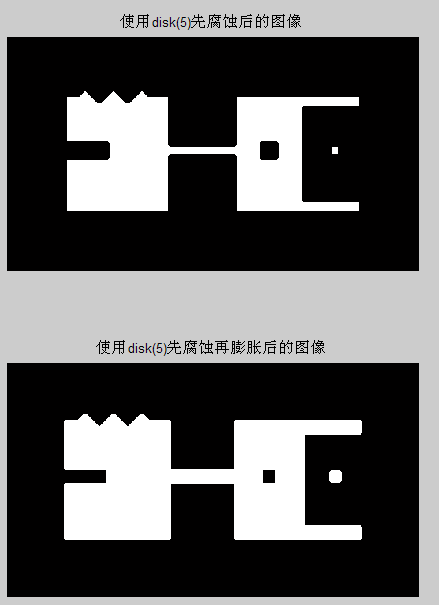
- %% imopen imclose在指纹上的应用
- clc
- clear
- f=imread('.\images\dipum_images_ch09\Fig0911(a)(noisy-fingerprint).tif');
- se=strel('square',3);%边长为3的方形结构元素
- subplot(121),imshow(f);
- title('指纹原始图像');
- A=imerode(f,se);%腐蚀
- subplot(122),imshow(A);
- title('腐蚀后的指纹原始图像');
指纹原始图像和腐蚀后的图像结果如下:

- fo=imopen(f,se);
- figure,subplot(221),imshow(fo);
- title('使用square(3)开操作后的图像');
- fc=imclose(f,se);
- subplot(222),imshow(fc);
- title('使用square闭操作后的图像');
- foc=imclose(fo,se);
- subplot(223),imshow(foc);
- title('使用square(3)先开后闭操作后的图像')
- fco=imopen(fc,se);
- subplot(224),imshow(fco);
- title('使用square(3)先闭后开操作后的图像');
指纹图像开闭操作过程结果如下:
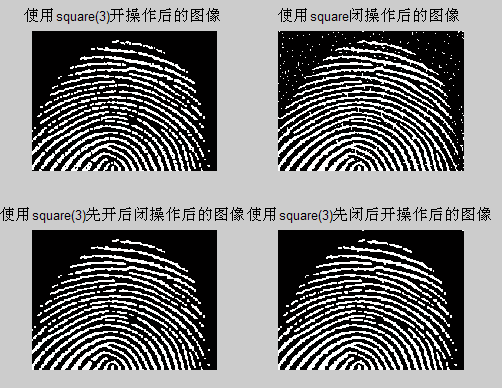
- %% bwhitmiss击中或击不中变换
- clc
- clear
- f=imread('.\images\dipum_images_ch09\Fig0913(a)(small-squares).tif');
- imshow(f);
- title('击中或不击中原始图像');
击中或不击中原始图像显示结果如下:
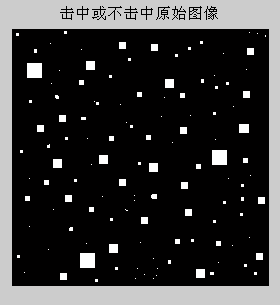
- B1=strel([0 0 0;0 1 1;0 1 0]);%击中:要求击中所有1的位置
- B2=strel([1 1 1;1 0 0;1 0 0]);%击不中,要求击不中所有1的位置
- B3=strel([0 1 0;1 1 1;0 1 0]);%击中
- B4=strel([1 0 1;0 0 0;0 0 0]);%击不中
- B5=strel([0 0 0;0 1 0;0 0 0]);%击中
- B6=strel([1 1 1;1 0 0;1 0 0]);%击不中
- g=imerode(f,B1)&imerode(~f,B2)%利用定义来实现击中或击不中
- figure,subplot(221),imshow(g);
- title('定义实现组1击中击不中图像');
- g1=bwhitmiss(f,B1,B2);
- subplot(222),imshow(g1);
- title('结构数组1击中击不中后的图像');
- g2=bwhitmiss(f,B3,B4);
- subplot(223),imshow(g2);
- title('结构数组2击中击不中的图像');
- g3=bwhitmiss(f,B5,B6);
- subplot(224),imshow(g3);
- title('结构数组3击中击不中的图像');
击中击不中变换后图像如下:
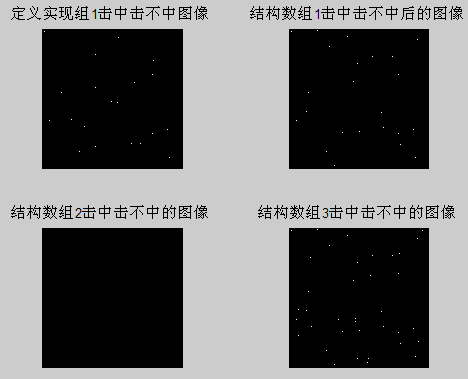
- %%makelut
- clc
- clear
- f=inline('sum(x(:))>=3');%inline是用来定义局部函数的
- lut2=makelut(f,2)%为函数f构造一个接收2*2矩阵的查找表
- lut3=makelut(f,3)
- %% Conway生命游戏
- clc
- clear
- lut=makelut(@conwaylaws,3);
- bw1= [0 0 0 0 0 0 0 0 0 0
- 0 0 0 0 0 0 0 0 0 0
- 0 0 0 1 0 0 1 0 0 0
- 0 0 0 1 1 1 1 0 0 0
- 0 0 1 0 0 0 0 1 0 0
- 0 0 1 0 1 1 0 1 0 0
- 0 0 1 0 0 0 0 1 0 0
- 0 0 0 1 1 1 1 0 0 0
- 0 0 0 0 0 0 0 0 0 0
- 0 0 0 0 0 0 0 0 0 0 ];
- subplot(221),imshow(bw1,'InitialMagnification','fit');
- title('Generation 1');
- bw2=applylut(bw1,lut);
- subplot(222),imshow(bw2,'InitialMagnification','fit'),
- title('Generation 2');
- bw3=applylut(bw2,lut);
- subplot(223),imshow(bw3,'InitialMagnification','fit');
- title('Generation 3');
- temp=bw1;
- for i=2:100
- bw100=applylut(temp,lut);
- temp=bw100;
- end
- subplot(224),imshow(bw100,'InitialMagnification','fit')
- title('Generation 100');
显示Generation结果如下:
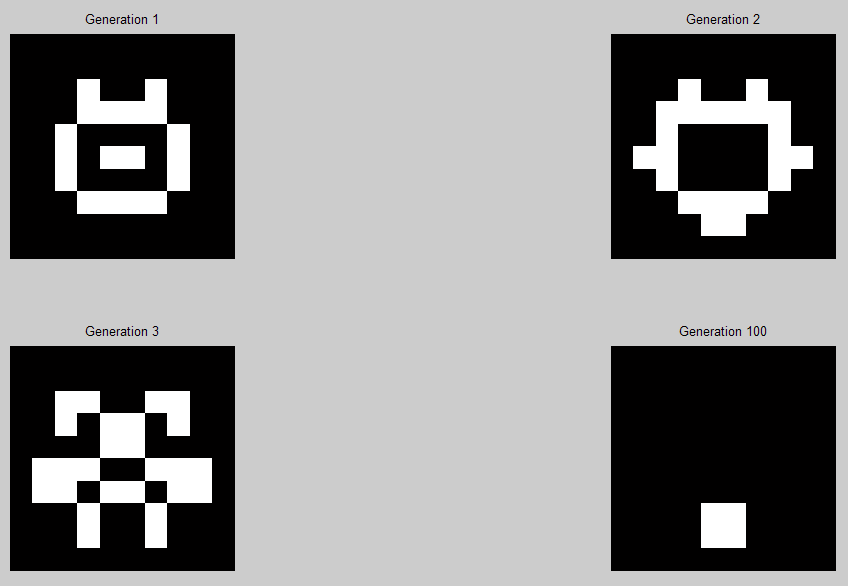
- %% getsequence
- clc
- clear
- se=strel('diamond',5)
- decomp=getsequence(se)%getsequence函数为得到分解的strel序列
- decomp(1)
- decomp(2)
- %% endpoints
- clc
- clear
- f1=imread('.\images\dipum_images_ch09\Fig0914(a)(bone-skel).tif');
- subplot(121),imshow(f1);
- title('原始形态骨架图像');
- g1=endpoints(f1);
- %set(gcf,'outerposition',get(0,'screensize'));%运行完后自动生成最大的窗口
- subplot(122),imshow(g1);
- title('骨架图像的端点图像');
骨架头像端点检测头像如下:
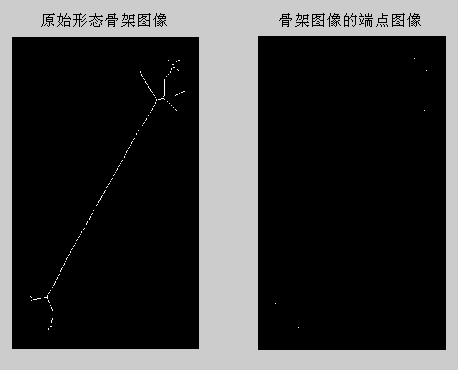
- f2=imread('.\images\dipum_images_ch09\Fig0916(a)(bone).tif');
- figure,subplot(121),imshow(f2);
- title('原始骨头图像');
- g2=endpoints(f2);
- subplot(122),imshow(g2);
- title('骨头图像端点头像');%结果是没有端点
骨头头像端点检测图像如下:
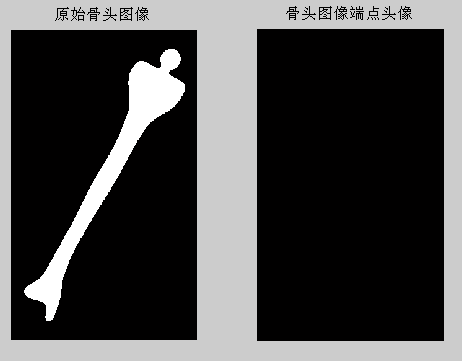
- %% bwmorph组合常见形态学之细化
- clc
- clear
- f=imread('.\images\dipum_images_ch09\Fig0911(a)(noisy-fingerprint).tif');
- subplot(221),imshow(f);
- title('指纹图像细化原图');
- g1=bwmorph(f,'thin',1);
- subplot(222),imshow(g1);
- title('指纹图像细化原图');
- g2=bwmorph(f,'thin',2);
- subplot(223),imshow(g2);
- title('指纹图像细化原图');
- g3=bwmorph(f,'thin',Inf);
- subplot(224),imshow(g3);
- title('指纹图像细化原图');
指纹图像细化过程显示如下:
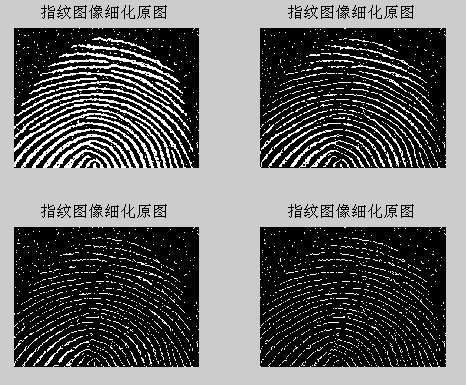
- %% bwmorph组合常见形态学之骨骼化
- clc
- clear
- f=imread('.\images\dipum_images_ch09\Fig0911(a)(noisy-fingerprint).tif');
- subplot(131),imshow(f);
- title('指纹图像骨骼化原图');
- fs=bwmorph(f,'skel',Inf);
- subplot(132),imshow(fs);
- title('指纹图像骨骼化');
- for k=1:5
- fs=fs&~endpoints(fs);
- end
- subplot(133),imshow(fs);
- title('指纹图像修剪后骨骼话');
指纹图像骨骼化过程显示:

- %% 使用函数bwlabel标注连通分量
- clc
- clear
- f=imread('.\images\dipum_images_ch09\Fig0917(a)(ten-objects).tif');
- imshow(f),title('标注连通分量原始图像');
其结果显示如下:
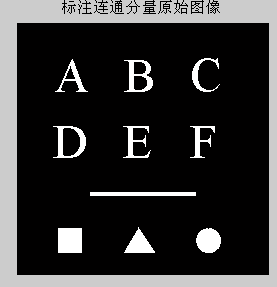
- [L,n]=bwlabel(f);%L为标记矩阵,n为找到连接分量的总数
- [r,c]=find(L==3);%返回第3个对象所有像素的行索引和列索引
- rbar=mean(r);
- cbar=mean(c);
- figure,imshow(f)
- hold on%保持当前图像使其不被刷新
- for k=1:n
- [r,c]=find(L==k);
- rbar=mean(r);
- cbar=mean(c);
- plot(cbar,rbar,'Marker','o','MarkerEdgeColor','k',...
- 'MarkerFaceColor','k','MarkerSize',10);%这个plot函数用法不是很熟悉
- plot(cbar,rbar,'Marker','*','MarkerFaceColor','w');%其中的marker为标记
- end
- title('标记所有对象质心后的图像');
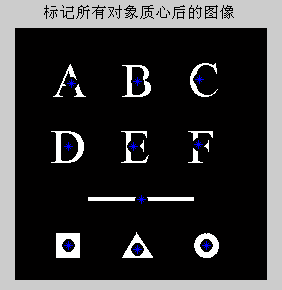
- %% 由重构做开运算
- clc
- clear
- f=imread('.\images\dipum_images_ch09\Fig0922(a)(book-text).tif');
- subplot(321),imshow(f);
- title('重构原始图像');
- fe=imerode(f,ones(51,1));%竖线腐蚀
- subplot(322),imshow(fe);
- title('使用竖线腐蚀后的结果');
- fo=imopen(f,ones(51,1));%竖线做开运算
- subplot(323),imshow(fo);
- title('使用竖线做开运算结果');
- fobr=imreconstruct(fe,f);%fe做标记
- subplot(324),imshow(fobr);
- title('使用竖线做重构开运算');
- ff=imfill(f,'holes');%对f进行孔洞填充
- subplot(325),imshow(ff);
- title('对f填充孔洞后的图像');
- fc=imclearborder(f,8);%清除边界,2维8邻接
- subplot(326),imshow(fc);
- title('对f清除边界后的图像');
图像重构过程显示如下:

- %% 使用顶帽变换和底帽变换
- clc
- clear
- f=imread('.\images\dipum_images_ch09\Fig0926(a)(rice).tif');
- subplot(221),imshow(f);
- title('顶帽底帽变换原始图像');
- se=strel('disk',10);%产生结构元素
- %顶帽变换是指原始图像减去其开运算的图像
- %而开运算可用于补偿不均匀的背景亮度,所以用一个大的结构元素做开运算后
- %然后用原图像减去这个开运算,就得到了背景均衡的图像,这也叫做是图像的顶帽运算
- f1=imtophat(f,se);%使用顶帽变换
- subplot(222),imshow(f1);
- title('使用顶帽变换后的图像');
- %底帽变换是原始图像减去其闭运算后的图像
- f2=imbothat(imcomplement(f),se);%使用底帽变换,为什么原图像要求补呢?
- %f2=imbothat(f,se);%使用底帽变换
- subplot(223),imshow(f2);
- title('使用底帽变换后的图像');
- %顶帽变换和底帽变换联合起来用,用于增加对比度
- f3=imsubtract(imadd(f,imtophat(f,se)),imbothat(f,se));%里面参数好像不合理?
- subplot(224),imshow(f3);
- title('使用顶帽底帽联合变换后图像');
顶帽底帽变换过程图像如下:
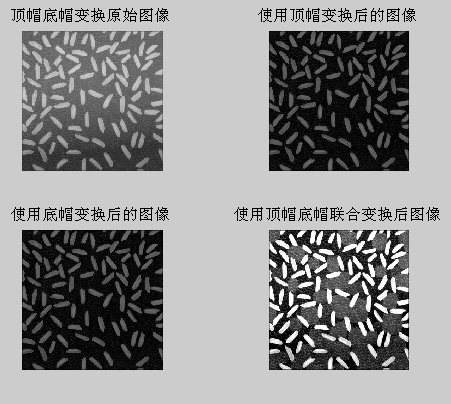
- %%使用开运算和闭运算做形态学平滑
- %由于开运算可以除去比结构元素更小的明亮细节,闭运算可以除去比结构元素更小的暗色细节
- %所以它们经常组合起来一起进行平滑图像并去除噪声
- clc
- clear
- f=imread('.\images\dipum_images_ch09\Fig0925(a)(dowels).tif');
- subplot(221),imshow(f);
- title('木钉图像原图');
- se=strel('disk',5);%disk其实就是一个八边形
- fo=imopen(f,se);%经过开运算
- subplot(222),imshow(f);
- title('使用半径5的disk开运算后的图像');
- foc=imclose(fo,se);
- subplot(223),imshow(foc);
- title('先开后闭的图像');
- fasf=f;
- for i=2:5
- se=strel('disk',i);
- fasf=imclose(imopen(fasf,se),se);
- end
- subplot(224),imshow(fasf);
- title('使用开闭交替滤波后图像');
使用开运算和闭运算做形态学平滑结果如下:
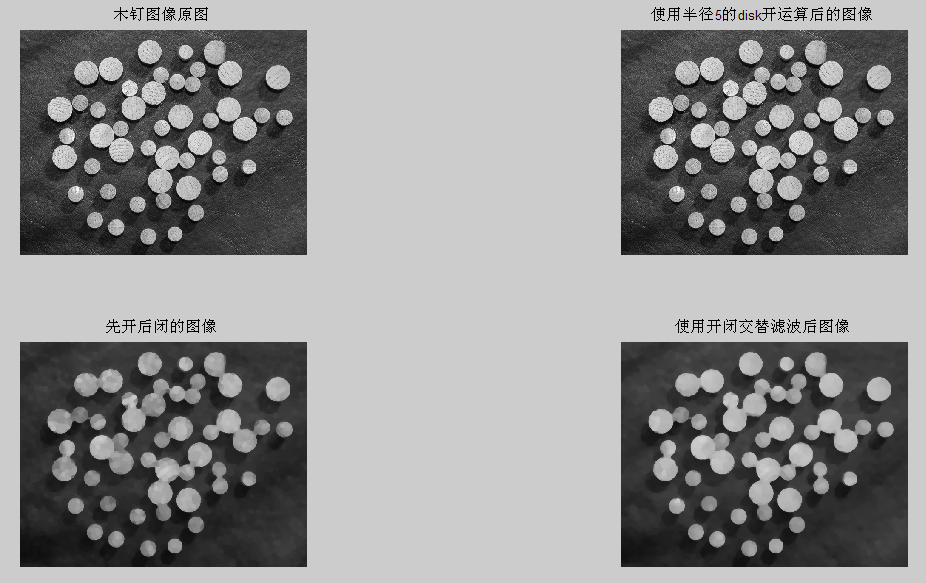
- %% 颗粒分析
- clc
- clear
- f=imread('.\images\dipum_images_ch09\Fig0925(a)(dowels).tif');
- sumpixels=zeros(1,36);
- for k=0:35
- se=strel('disk',k);
- fo=imopen(f,se);
- sumpixels(k+1)=sum(fo(:));
- end
- %可以看到,连续开运算之间的表面积会减少
- plot(0:35,sumpixels),xlabel('k'),ylabel('surface area');
- title('表面积和结构元素半径之间的关系');
其运算结果如下:
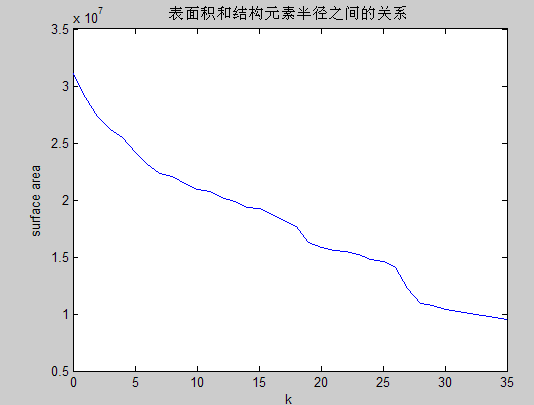
- figure,plot(-diff(sumpixels));%diff()函数为差分或者近似倒数,即相邻2个之间的差值
- xlabel('k'),ylabel('surface area reduction');
- title('减少的表面积和结构元素半径之间的关系');
其运算结果如下:

- %% 使用重构删除复杂图像的背景
- clc
- clear
- f=imread('.\images\dipum_images_ch09\Fig0930(a)(calculator).tif');
- subplot(221),imshow(f);
- title('灰度级重构原图像');
- f_obr=imreconstruct(imerode(f,ones(1,71)),f);
- subplot(222),imshow(f_obr);
- title('经开运算重构图');
- f_o=imopen(f,ones(1,71));
- subplot(223),imshow(f_o);
- title('经开运算后图');
- f_thr=imsubtract(f,f_obr);
- subplot(224),imshow(f_thr);
- title('顶帽运算重构图')
使用重构删除复杂图像的背景1:
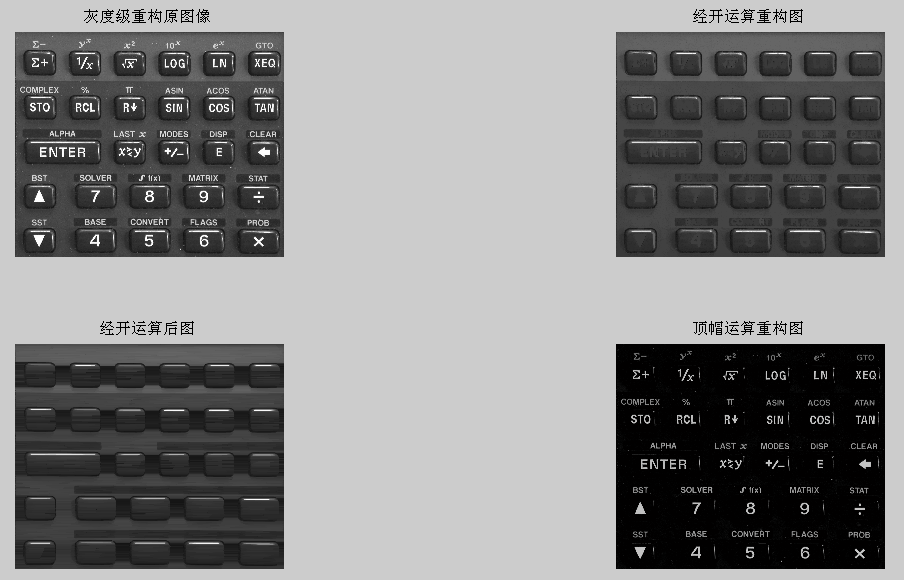
- f_th=imsubtract(f,f_o)
- figure,subplot(221),imshow(f_th);
- title('经顶帽运算图');
- g_obr=imreconstruct(imerode(f_thr,ones(1,11)),f_thr);
- subplot(222),imshow(g_obr);
- title('用水平线对f_thr经开运算后重构图');
- g_obrd=imdilate(g_obr,ones(1,2));
- subplot(223),imshow(g_obrd);
- title('使用水平线对上图进行膨胀');
- f2=imreconstruct(min(g_obrd,f_thr),f_thr);
- subplot(224),imshow(f2);
- title('最后的重构结果');
使用重构删除复杂图像的背景2:









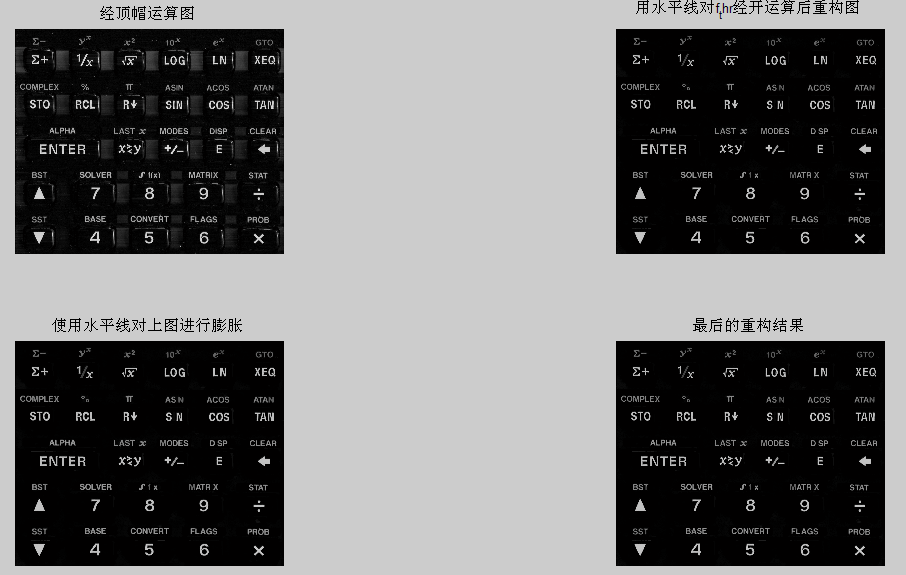














 2702
2702











 被折叠的 条评论
为什么被折叠?
被折叠的 条评论
为什么被折叠?








